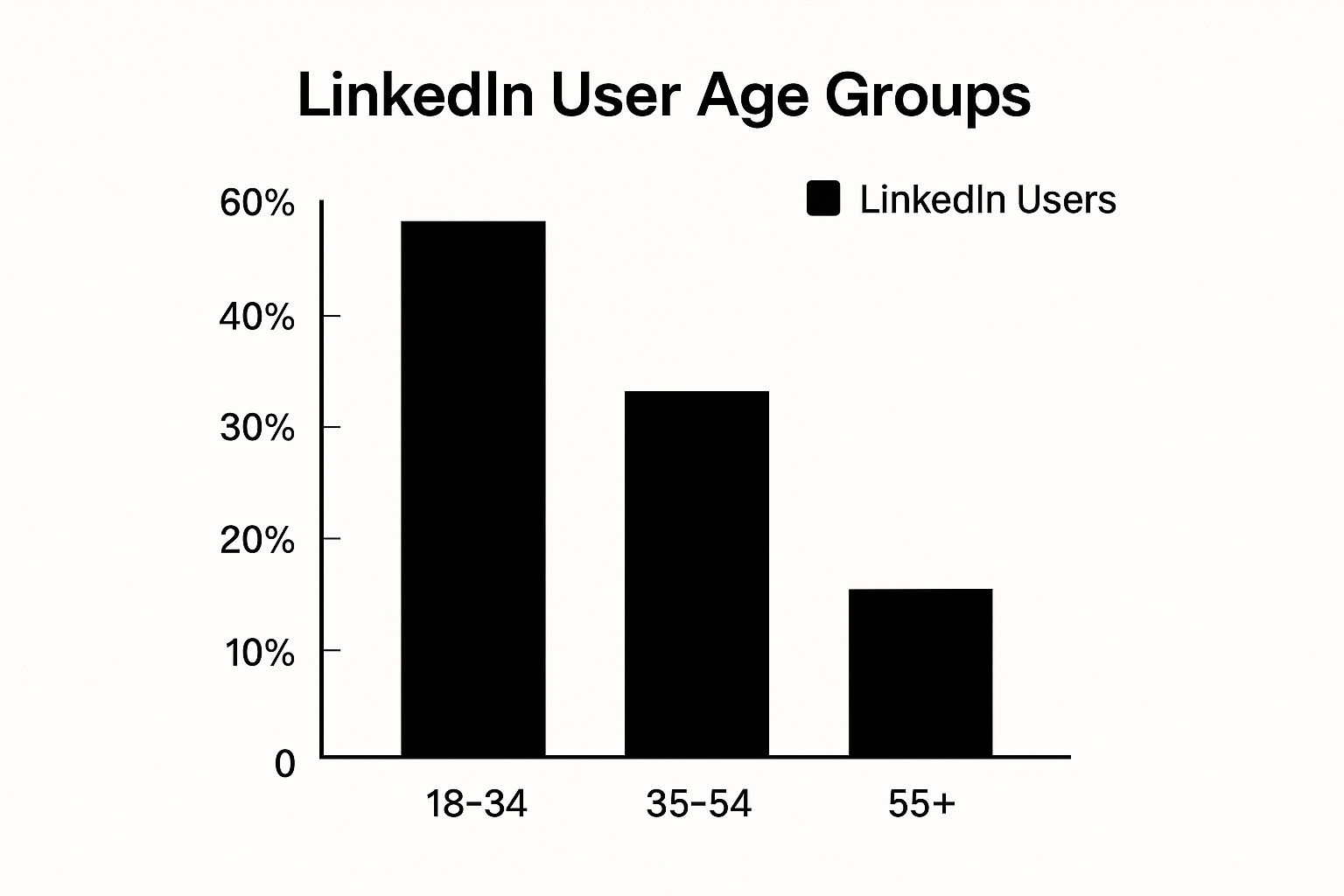
LinkedIn Write an Article That Actually Gets Read
Published on 2025-06-18
Understanding What Makes LinkedIn Articles Different
Before you even think about writing your first sentence, let's get one thing straight: LinkedIn is not just another blogging platform. Think of it less like a public square for casual chatter and more like a focused industry summit. The people here aren't just scrolling to kill time; they’re actively looking for knowledge, solutions, and ways to grow in their careers. Your content isn’t competing with vacation photos, but with expert analysis and industry reports. This difference in why people are here changes everything.
The Professional Mindset: Intent Is Everything
Readers on LinkedIn are on a mission. It might be a marketing manager hunting for a new campaign strategy, a software developer digging into a new framework, or a founder trying to figure out how to scale their business. They are spending their limited time on content that promises a real return—whether it's a new skill, a fresh perspective, or a solution to a problem that's been bugging them. Your article has to deliver on that promise.
This focused audience is also huge. The platform pulls in a staggering 1.77 billion unique visits every month, making it a major hub for professionals. It’s no surprise that 80% of B2B marketers use LinkedIn for their marketing, and 70% say they see a positive return on that effort. By 2025, it's expected that 43% of consumers around the world will have a LinkedIn profile. Discover more on these powerful LinkedIn stats.
Content That Connects: Beyond the Standard Blog Post
Because the reader's goal is different, your content has to be, too. A generic listicle that might do well on another site will likely fall flat here. Instead, the articles that truly succeed on LinkedIn offer real substance. They often provide:
- In-depth analysis: A detailed breakdown of a recent industry shift and what it actually means for professionals on the ground.
- Personal stories with lessons: Sharing a real-world professional failure or success and, most importantly, pulling out actionable takeaways for the reader.
- Practical frameworks: Offering a clear, step-by-step guide to solving a specific and common challenge people face at work.
The aim isn't just to inform but to empower. Your article should feel like getting valuable advice from a trusted mentor or a sharp colleague. Understanding this difference is the most important part of the process; it's the foundation for everything else. For a deeper look, check out our complete guide on writing a LinkedIn article that drives results.
Writing Headlines That Make Professionals Stop Scrolling
Let's be honest, your LinkedIn article lives or dies by its headline. It’s your one shot to stop a busy professional mid-scroll and convince them to invest their most precious asset: their time. A weak headline means even a brilliant article will gather digital dust.
Think of your headline not as a title, but as a direct pitch. It needs to make a specific, compelling promise that sparks enough interest to earn a click.
Balancing Clarity and Curiosity
A great headline walks a fine line between telling the reader what the article is about and making them curious to learn more. Vague headlines get ignored, but overly dry ones are just as bad.
For instance, "Thoughts on Project Management" is a guaranteed scroll-past. But what about, "The One Project Management Mistake That's Secretly Costing Your Company Thousands"? The first is forgettable; the second creates an immediate, tangible reason to click. It promises a specific insight with a clear consequence.
Speak Your Audience's Language
To write an article for LinkedIn that truly connects, you have to know who you’re talking to. A headline that grabs a recent graduate's attention will likely miss the mark with a seasoned executive. Understanding who uses the platform is your first step.
This chart breaks down LinkedIn's user base by age, and it tells a fascinating story.

With a massive 60% of users in the 18-34 age bracket, headlines that focus on career growth, new skills, and getting ahead are incredibly effective. For the established 35-54 demographic, you'll find more success with headlines that signal strategic insight, leadership value, and industry-level impact.
To help you craft your next great headline, I've put together a quick comparison of some proven formulas that consistently get results on the platform.
High-Performing LinkedIn Article Headline Formulas
Comparison of different headline structures and their average engagement rates
| Headline Formula | Example | Average Engagement Rate | Best Used For |
|---|---|---|---|
| The Numbered List | "7 Ways to Improve Team Efficiency by 25%" | High | How-to guides, listicles, and scannable content that promises tangible takeaways. |
| The Provocative Question | "Are You Making This Common Leadership Error?" | Medium-High | Thought leadership, challenging industry norms, and content that prompts self-reflection. |
| The Clear Outcome | "The Ultimate Guide to Landing Your Next Client in Under 30 Days" | High | Tutorials, detailed guides, and case studies where the benefit is the main draw. |
The main insight here is that the best headlines are specific and promise clear value. Each of these formulas tells the reader exactly what they stand to gain, respecting their time and intelligence.
Your headline isn't an afterthought; it's the single most critical element for driving engagement. Always draft several options and get a second opinion before you publish. A few minutes of extra work here can dramatically change your article's reach.
Structuring Content That Busy Professionals Actually Read
 Let's be honest: the professionals you want to reach on LinkedIn are master multitaskers. They’re scrolling through their feed between meetings or during their morning commute. They don't read articles from top to bottom; they scan for value. A massive wall of text is the fastest way to get them to close the tab.
Let's be honest: the professionals you want to reach on LinkedIn are master multitaskers. They’re scrolling through their feed between meetings or during their morning commute. They don't read articles from top to bottom; they scan for value. A massive wall of text is the fastest way to get them to close the tab.
Think of your article's structure as its first impression. It's not just a container for your words; it’s a signal that you respect their time and have something important to say.
Design for the Skim-Reader
To write a successful LinkedIn article, you have to embrace scannability. Since most people are on their phones, long paragraphs can look overwhelming. Your goal is to make your article easy to digest at a glance.
Use bold text to make critical points stand out. Keep your paragraphs short and punchy—aim for just two to four sentences. Subheadings act like signposts on a highway, allowing a busy reader to understand the main points in seconds. This approach makes them far more likely to slow down and commit to reading the whole piece.
The Anatomy of an Engaging Article
The most effective articles guide the reader through a simple, logical journey. While some data suggests that articles between 1,500 and 2,000 words perform well, it’s the structure—not the length—that truly captures and holds attention.
A great article generally follows this flow:
- The Hook: Your introduction needs to present a relatable problem or a compelling insight right away. Give them a reason to stop scrolling and pay attention.
- The Value: The body of your article is where you deliver on the promise of your hook. This is where you provide the solution or evidence, broken down into digestible, well-organized sections.
- The Takeaway: A strong conclusion summarizes your main point and gives the reader a clear next step. Asking a direct question is a great way to invite comments and start a conversation.
Ultimately, a well-structured article shows you’ve organized your thoughts so your reader doesn’t have to. This consideration builds the trust that encourages the shares, comments, and connections that mark truly successful content on the platform.
Building Your Professional Brand Through Strategic Content
 When you write an article on LinkedIn, you’re doing more than just sharing information—you’re laying a cornerstone for your professional brand. Each piece is a chance to tell your network who you are, what you believe in, and why your perspective is valuable. It's how you become a trusted voice, not just another connection in someone's feed.
When you write an article on LinkedIn, you’re doing more than just sharing information—you’re laying a cornerstone for your professional brand. Each piece is a chance to tell your network who you are, what you believe in, and why your perspective is valuable. It's how you become a trusted voice, not just another connection in someone's feed.
Finding Your Authentic Voice
The most engaging creators on any platform are the ones who successfully blend their professional expertise with a dose of their own personality. They aren't afraid to share a story about a project that went sideways or a surprising lesson they learned from a mistake. This kind of vulnerability doesn't hurt your credibility; it makes you human and relatable.
To find that sweet spot, try focusing on a few things:
- Pinpoint your niche: What specific subject can you own and become the go-to person for?
- Share your "why": Don't just talk about what you do. Explain why it drives you and why it should matter to others.
- Use real-life stories: Instead of a generic statement like "communication is key," describe a specific time when a particular communication tactic saved a project from failing.
This authentic approach is at the heart of how you can effectively build your personal brand on LinkedIn.
Turning Insight into Opportunity
Smartly crafted content doesn't just collect likes; it opens doors to real-world opportunities. And you're not just speaking to your current network—the potential reach is massive. Since 2019, LinkedIn's user base has exploded by nearly 80%, growing from 644 million to an expected 1.15 billion users by 2025. This growth means your expertise has a truly global stage. You can explore these incredible LinkedIn growth stats to see for yourself.
Professionals have used a single, well-written article to secure six-figure consulting contracts, land keynote speaking invitations at major conferences, or get on the radar of a recruiter for their dream job. They pull this off by consistently tackling industry challenges and showing that they are forward-thinking problem-solvers. Your article transforms into a living resume, showing not just what you've accomplished, but how you think. It's proof of your value in action.
Getting Your Articles Discovered Through Smart Optimization
Hitting “publish” is a great feeling, but your work isn’t over. To make sure the right people see what you've written when you write an article on LinkedIn, you have to play by the algorithm's rules. LinkedIn gives a big boost to content that gets people talking—not just likes, but thoughtful comments and shares—especially within the first few hours. That early buzz tells LinkedIn your article is a hot topic and deserves a bigger audience.
Leverage Native Features Strategically
Don't just post your article and hope for the best. You need to be proactive and use LinkedIn's own tools to give your content a nudge and help it travel beyond your immediate network.
- Hashtags: Think of these as signposts for your content. Use a mix of 3-5 hashtags that are relevant to your topic. You’ll want to combine a couple of broad, popular tags (like #Marketing) with more focused, niche ones (like #B2BContentStrategy). This helps you attract a wider audience while also reaching the specific people who will find your article most valuable.
- Tagging: If you mentioned a company or quoted an expert in your article, be sure to tag them. This sends a notification their way, making it super easy for them to see your piece and share it with their own followers. It’s a simple way to get more eyes on your work.
LinkedIn even gives us a peek into how it shares content in its own help documentation.

This screenshot shows that LinkedIn’s system is actively analyzing your content for keywords and topics to match it with users who have shown interest in those areas. This makes your choice of hashtags incredibly important for getting found.
Cross-Promote for Maximum Impact
Your article deserves its own mini-launch party. Always create a separate LinkedIn post to announce it. Don't just drop the link and run; make the post engaging on its own. Pull out a surprising statistic or a thought-provoking quote from your article and ask your network a direct question about it. This is how you start a real conversation.
Timing matters, too. For B2B audiences, posting on a Tuesday or Wednesday morning often leads to the best engagement. This promotional push is a key part of any good content strategy for LinkedIn. Remember, building that initial momentum is everything.
Using Data and Tools To Improve Your LinkedIn Writing
Publishing an article is a great feeling, but the real work begins after you hit that button. To consistently create content that connects, you can't just guess what your audience wants. The most successful creators use data to guide their strategy, turning each article into a learning opportunity.
LinkedIn’s built-in analytics are your first stop. It’s easy to get caught up in big numbers, but you need to focus on the metrics that signal genuine interest. This data tells you exactly what to write next and how to get it in front of the right people.
What to Measure in LinkedIn Analytics
Instead of getting lost in a sea of numbers, let's zero in on the metrics that truly reveal your article's performance. These are the key indicators that tell a story about what's working and what isn't.
Essential LinkedIn Article Metrics and Their Meanings Key performance indicators for LinkedIn articles and how to interpret them
| Metric | What It Measures | Good Benchmark | Action to Take |
|---|---|---|---|
| Article Views | The total number of times your article has been seen. | Varies widely. Aim for consistent growth over your average. | If low, re-evaluate your headline and promotion strategy. |
| Click-Through Rate (CTR) | The percentage of people who clicked your article from a post. | Above 2-3% is solid. | A low CTR suggests your promotional post isn't compelling enough. |
| Comments | The number of conversations your article sparked. | More important than likes; indicates deep engagement. | If low, end articles with a direct, thought-provoking question. |
Ultimately, the data shows that engagement, especially comments, is a stronger signal of success than just views. An article that sparks a meaningful conversation is far more valuable than one that gets thousands of passive views.
Beyond Native Analytics: Helpful Tools
While LinkedIn's analytics give you a great rearview mirror, a few external tools can help you steer your content more effectively before you even publish. Think of it as building your writer's toolkit.
For instance, headline analyzers can help you test different titles to see which one is most likely to grab attention. Scheduling tools can make sure your promotional posts go live when your audience is most active.
When you're facing writer's block or just need to get ideas on paper, an AI assistant like autoghostwriter can be incredibly useful. It can help you generate a first draft or flesh out a section, getting you past that initial hurdle. You can then step in to add your personal stories, expertise, and unique voice. Combining these tools with solid data gives you a repeatable process for turning your ideas into articles that perform.
Turning Your Articles Into Real Professional Opportunities
It’s easy to get caught up in likes and views, but the real magic of a great LinkedIn article happens after you hit publish. A well-crafted article is more than just content; it’s a digital handshake that works for you 24/7, sparking conversations and opening doors you might not have seen coming.
From Comments to Conversations
Your work isn’t done once the article is live. The comment section is where real relationships begin to form. Instead of dropping a generic "Thanks for reading!", take a moment to dig a little deeper. If someone leaves a thoughtful comment, check out their profile. Could they be a potential client or an interesting peer in your field? Keep the conversation alive by asking a follow-up question.
Then, take the next step by sending a personalized connection request. This small action can turn a passive reader into a valuable part of your professional network.
- For example: "Hi Sarah, I really appreciate your insightful comment on my article about project management pitfalls. It’s clear you have experience in this area. I'd love to connect and follow your work."
Your Article as a Professional Asset
Don't just let your articles sit on your profile. Think of them as part of your professional toolkit, ready to be used in specific situations to build your career or business.
Imagine a recruiter asks about your leadership style. You could say, "That's a great question. I actually wrote an in-depth article on my philosophy of transparent leadership that I can share." Or, before a big sales call, you could send a relevant article to a potential client that addresses one of their key pain points. This positions you as a helpful expert before the meeting even starts.
Measuring What Really Matters
Ultimately, it's important to look past the surface-level numbers. The true return on your investment when you write an article for LinkedIn isn't the view count. It’s the number of inbound connection requests from people you admire, the direct messages from potential clients who mention your work, and the invitations you get to speak at events or collaborate on projects.
That’s how you know your content is making a real-world impact.
Ready to create content that opens these kinds of doors? Let autoghostwriter help you craft articles that build both your brand and your career.